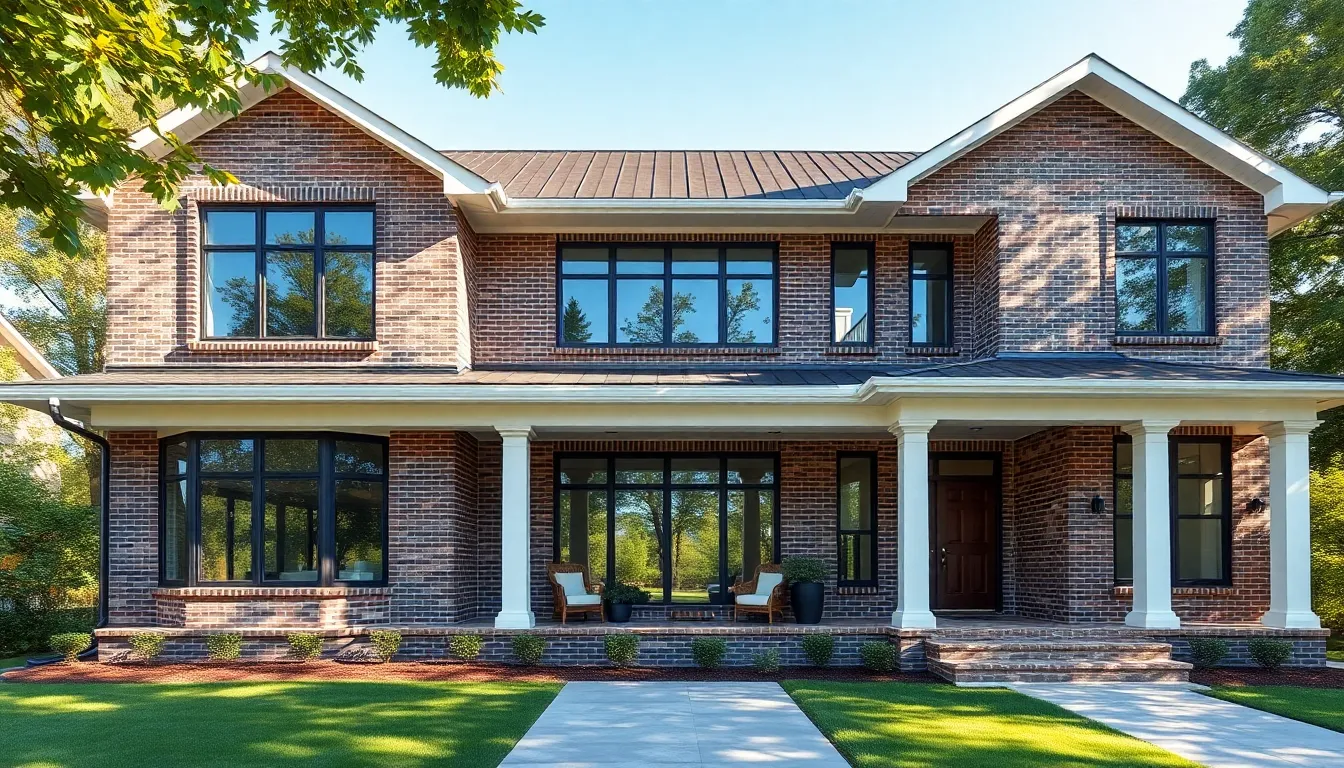Transitional home architecture seamlessly blends traditional and contemporary design elements, creating spaces that feel both timeless and fresh. This style caters to those who appreciate the charm of classic aesthetics while embracing modern conveniences. It’s a versatile approach that resonates with homeowners seeking comfort and elegance in their living environments.
In recent years, transitional architecture has gained popularity, reflecting a shift in lifestyle preferences. With an emphasis on open spaces, natural light, and functional layouts, this design philosophy promotes a harmonious balance between form and function. Whether it’s a cozy family home or a sleek urban dwelling, transitional architecture offers a unique solution that meets diverse needs while maintaining a cohesive look.
Table of Contents
ToggleOverview Of Transitional Home Architecture
Transitional home architecture blends traditional and contemporary design elements, creating timeless living spaces. This architectural style suits those who appreciate classic aesthetics while incorporating modern functionality.
Definition And Characteristics
Transitional architecture embodies a balance between historical and modern influences. It features clean lines, muted color palettes, and a mix of materials. Homeowners often find large, open spaces within these designs, enhancing both light and flow. Fluidity in layout allows for practicality while maintaining visual appeal. Elements from various styles harmoniously intertwine, resulting in a cohesive, inviting atmosphere.
Key Design Elements
- Color Palette: Neutral tones dominate, providing a subtle backdrop that complements both traditional and modern accents.
- Materials: A mix of stone, wood, glass, and metal contributes to texture and depth, integrating the old with the new.
- Furniture: Eclectic furniture choices often emerge, combining classic pieces with contemporary designs, creating a unique aesthetic balance.
- Lighting: Natural light takes precedence, with large windows and open floor plans enhancing interior brightness.
- Floor Plans: Open-concept layouts encourage spaciousness and adaptability, ideal for modern lifestyle needs.
- Architectural Features: Crown molding, coffered ceilings, and wainscoting are common, blending nostalgia with contemporary elegance.
Historical Context

Transitional home architecture has evolved as a response to changing aesthetic and functional demands throughout history. By melding traditional and contemporary design aspects, it provides a rich narrative of architectural development.
Evolution Of Transitional Design
Transitional design traces its roots to the early 20th century when architects began to challenge strict traditional styles. The mid-century modern movement introduced new materials and open spaces, influencing transitional aesthetics. As homeowners desired comfort alongside style, transitional architecture emerged, incorporating features from various historical periods while embracing modern sensibilities. This design trend gained momentum in the late 1990s, promoting spaciousness, minimalist decor, and lighter color schemes.
Influences On Modern Architecture
Transitional architecture reflects numerous influences, including the Arts and Crafts movement, which celebrated craftsmanship and organic materials. Modernism has also significantly impacted, emphasizing simplicity and functionality. Additionally, sustainability trends shape contemporary practices through the integration of eco-friendly materials and designs that maximize energy efficiency. Globalization has further brought diverse cultural elements into the mix, enriching transitional architecture’s characteristics with various textures, colors, and layouts.
Key Features Of Transitional Homes
Transitional homes showcase a harmonious balance between traditional and contemporary design elements, creating inviting spaces that cater to modern lifestyles. Key features of these homes include a blend of styles, strategic use of color, and diverse materials.
Blend Of Traditional And Contemporary Styles
Transitional homes integrate classic and modern design elements seamlessly. Architectural details like crown molding and wainscoting evoke traditional charm, while sleek lines and minimalism reflect contemporary aesthetics. Furniture choices often mix styles; for instance, a plush, traditional sofa complements a modern coffee table. This combination allows for flexibility, accommodating diverse tastes while maintaining aesthetic cohesiveness.
Use Of Color And Materials
Transitional homes employ a neutral color palette for a serene atmosphere. Soft hues like beige, gray, and white create a backdrop that enhances design versatility. Materials play a crucial role; homeowners frequently combine wood, stone, glass, and metal. For example, a wooden dining table can pair well with metal chairs, adding texture and visual interest. Large windows facilitate natural light, emphasizing openness and connection to the outdoors, further enhancing overall ambiance.
Benefits Of Transitional Home Architecture
Transitional home architecture offers numerous advantages, blending comfort with modern design. Its unique characteristics cater to diverse homeowner preferences.
Aesthetic Appeal
Aesthetic appeal defines transitional homes, merging the best of both traditional and modern styles. Homeowners appreciate clean lines and subtle color palettes that create a sophisticated ambiance. Architectural elements like crown molding and coffered ceilings add elegance, while large windows facilitate natural light. The combination of textures from wood, stone, glass, and metal enhances visual interest, producing inviting spaces that maintain timelessness while appearing contemporary.
Flexibility And Functionality
Flexibility and functionality characterize transitional architecture, adapting to various lifestyles effortlessly. Open floor plans promote free movement between spaces, enhancing social interaction and family cohesion. Homeowners find that this design serves multiple purposes, offering areas for relaxation, work, and entertaining. The ability to customize layouts ensures living environments remain practical, meeting evolving needs and preferences without sacrificing style.
Popular Transitional Home Designs
Transitional home designs showcase a seamless blend of classic and modern styles, offering both elegance and functionality. Key areas of focus include interior design trends and outdoor spaces, which together enhance the overall aesthetic appeal of transitional homes.
Interior Design Trends
Transitional interiors prioritize balance and comfort, featuring a combination of traditional and contemporary elements. Key trends include:
- Neutral Color Palettes: Soft shades like beige, gray, and white dominate, creating calming environments while allowing for versatile decor choices.
- Eclectic Furniture Styles: Homeowners mix classic pieces with modern furnishings, fostering innovation and personalized aesthetics.
- Textural Variety: Using materials such as wood, stone, glass, and metal introduces depth and interest to each space.
- Natural Light Emphasis: Large windows enhance illumination and foster connections with outdoor surroundings, vital in transitional design.
- Stylish Architectural Details: Features like crown molding, coffered ceilings, and wainscoting add character and sophistication, marrying nostalgia with contemporary appeal.
Outdoor Spaces
Transitional home architecture extends its design principles into outdoor areas, promoting harmony and connectivity. Focus areas include:
- Seamless Transitions: Open layouts between indoor and outdoor spaces encourage fluid movement and interaction, enhancing the living experience.
- Landscaping Elements: Thoughtfully arranged gardens and greenery enhance aesthetics while promoting natural beauty and tranquility.
- Functional Patios: Outdoor dining and lounge areas often incorporate modern furniture, creating inviting spaces for relaxation or entertainment.
- Architectural Features: Overhangs, pergolas, or decks blend with the home’s exterior, ensuring cohesive design and maximizing outdoor usability.
- Natural Materials: Use of stone, wood, and metal in outdoor settings reinforces the connection to the home while adding a timeless quality.
These aspects of transitional home architecture illustrate the harmonious integration of style, functionality, and comfort in both interior and outdoor environments.
Transitional home architecture stands as a testament to the evolving preferences of modern homeowners. By seamlessly merging traditional and contemporary elements it creates spaces that are not only visually appealing but also highly functional. This architectural style caters to diverse lifestyles while promoting comfort and adaptability.
With its emphasis on open spaces and natural light transitional design fosters a sense of connection to the outdoors. Homeowners can enjoy the best of both worlds through thoughtful integration of classic details and modern conveniences. As the demand for versatile living spaces continues to grow transitional architecture will undoubtedly remain a popular choice for those seeking elegance and practicality in their homes.


